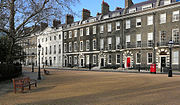Queen Square, London

Queen Square is a garden square in the Bloomsbury district of central London. Many of its buildings are associated with medicine, particularly neurology.
Construction

Queen Square was originally constructed between 1716 and 1725. It was formed from the garden of the house of

Queen Charlotte and treatment for George III
A statue contained within the square was misidentified as depicting
Queen Charlotte's husband, King
The
Late 19th century
Built in the early 18th century as a fashionable area, by the mid-19th century it had attracted many French refugees and the shops of sundry booksellers and print sellers. It became a favoured centre for charitable institutions, including the Roman Catholic
Gradually the mansions were turned into hospitals and other institutions.[1] The first institution which is still in the square was started by Johanna Chandler in 1860.[3] Elizabeth Malleson started the Working Women's College here in 1864.[4]
The College of Preceptors (also known as the
In 1861, just a year after the first Victorian Turkish bath opened in London, an establishment calling itself the Ladies' True Turkish Bath, opened at No.26.[6] It was the only such bath in London open for women daily. It remained open till 1865, during which time over 37,000 baths were taken.[7]
20th and 21st centuries
Many of the buildings surrounding the square are devoted to providing, researching and administering health care. Two hospitals, the
Several buildings on the west side of the square are devoted to medical research and are part of the Institute of Neurology and other departments of UCL. These include Alexandra House at number 17, which houses the
At the southern end of the square is the church mentioned above, the
A women-only Victorian-style Turkish bath, the women's section of the Imperial Hotel's Turkish baths, had its own additional entrance in Queen Square from 1930 to 1962.[10][11] The site continues to be occupied by the new Imperial Hotel.
One of the buildings, the
Notable residents
- Edward Arber, literary scholar and anthologist, and his son E.A.N. Arber, botanist, at No 5 in the 1870s.[13]
- Sir William Browne, physician, 1749–1774[14]
- Fanny Burney, novelist, 1770–1774
- Frances Reynolds, painter, 1792–1807
- Francis Ronalds, inventor, 1820–1822[15]
- Frederick Denison Maurice Theologian and founder of The Working Men's College. At No 5 and No 21.[16]
See also
References
- ^ a b 'Queen Square and Great Ormond Street', Old and New London: Volume 4 (1878), pp. 553-564
- ^ Benham, William, ed. (1887). Dictionary of Religion. London: Cassel. p. 976.
- ^ Jennett Humphreys, ‘Chandler, Johanna (1820–1875)’, rev. Patrick Wallis, Oxford Dictionary of National Biography, Oxford University Press, 2004 accessed 7 Dec 2014
- ^ Owen Stinchcombe, ‘Malleson, Elizabeth (1828–1916)’, rev. Oxford Dictionary of National Biography, Oxford University Press, 2004 accessed 29 July 2015
- ^ "UCL Bloomsbury Project". www.ucl.ac.uk.
- ^ '[Advertisement]'. Morning Post. (17 May 1861). p.4
- ^ The Hammam of the Turks: the thermæ of the Romans restored in Britain. (Collected fly sheets). (London: The Hammam, [c.1867])
- ^ "UCL Bloomsbury Project". www.ucl.ac.uk.
- ^ Mary Ward Centre: Notes on the History of Queen Square
- ^ "Queen Square Archive - QSA/15196 - Ladies Turkish Baths in Queen Square". queensquare.org.uk.
- ^ Shifrin, Malcolm. (2015). Victorian Turkish baths. (Swindon: Historic England). pp.220—222
- ^ a b Accounts from past students
- ^ The Papers of Edward Alexander Newell Arber, Sedgwick Museum of Earth Sciences, University of Cambridge
- ^ "AIM25: Archives in London and the M25 area".
- ISBN 978-1-78326-917-4.
- ^ "UCL Bloomsbury Project".
- Richard Tames. Bloomsbury Past (ISBN 0-948667-20-6
- Godfrey Heathcote Hamilton. Queen Square (Leonard Parsons, Edition 1926)
External links
- History of Queen Square
- Bloomsbury Project - University of London
- THE ART WORKERS’ GUILD – 125 years History - 6 Queen Square, Bloomsbury, London
- Queen Square Neurology Archive, an extensive archive of historical documents relating to the neurology institutions in Queen Square
- History of 42-43 Queen Square – Mary Ward Center
- Map

